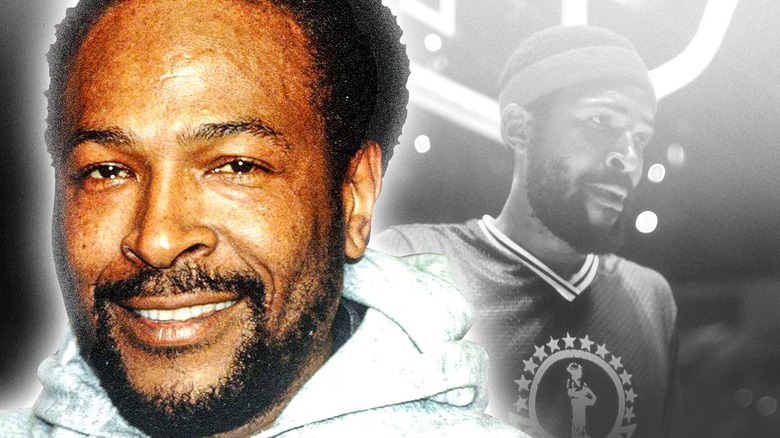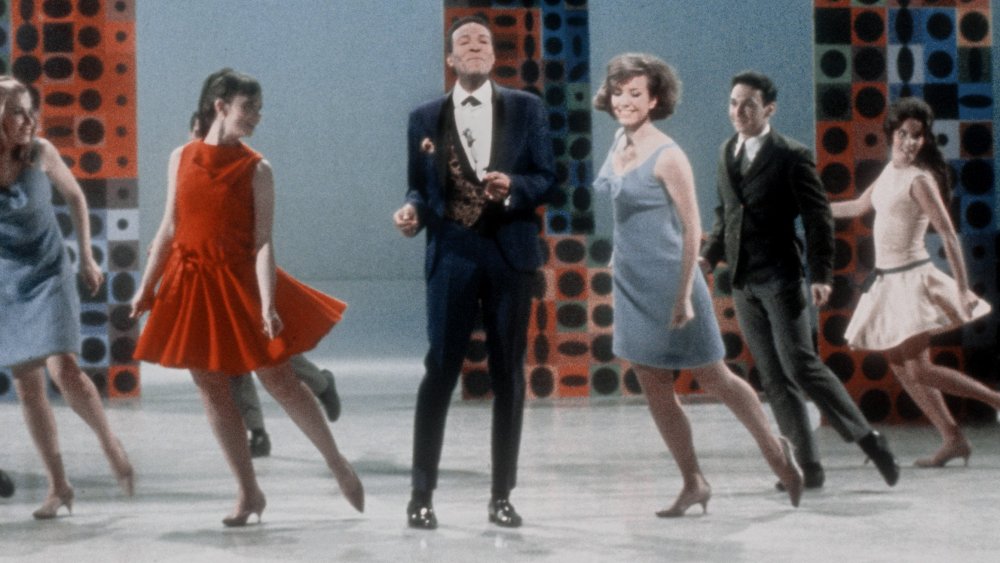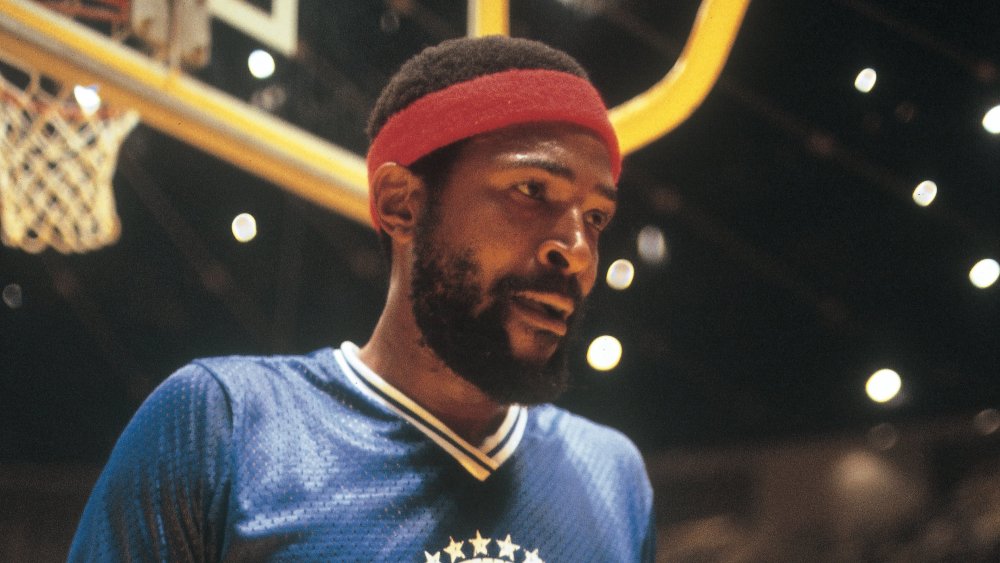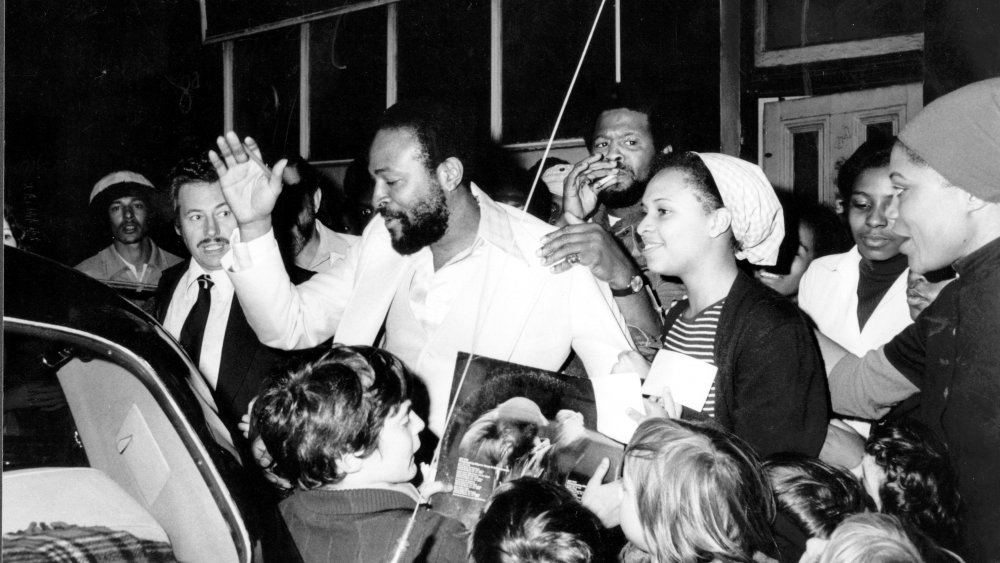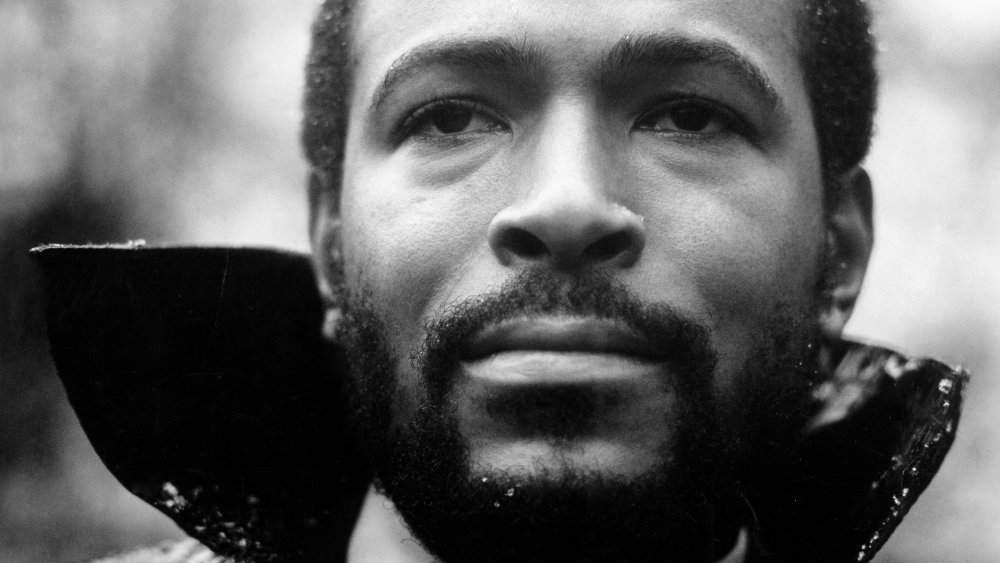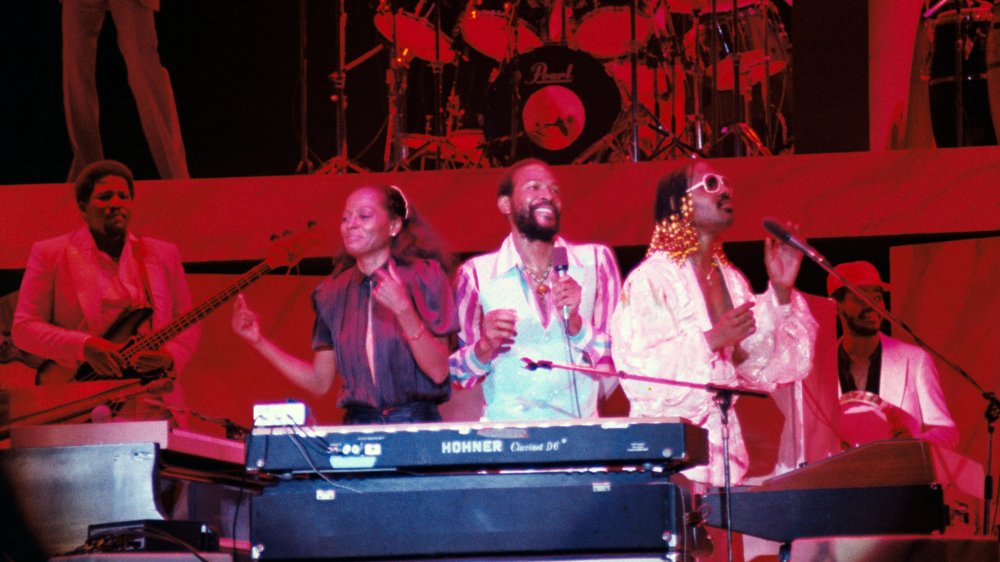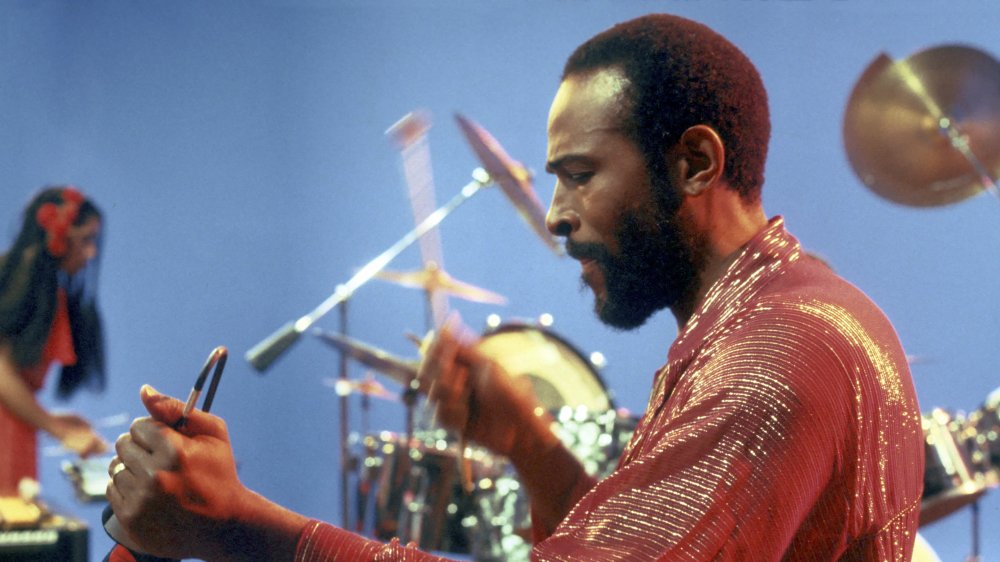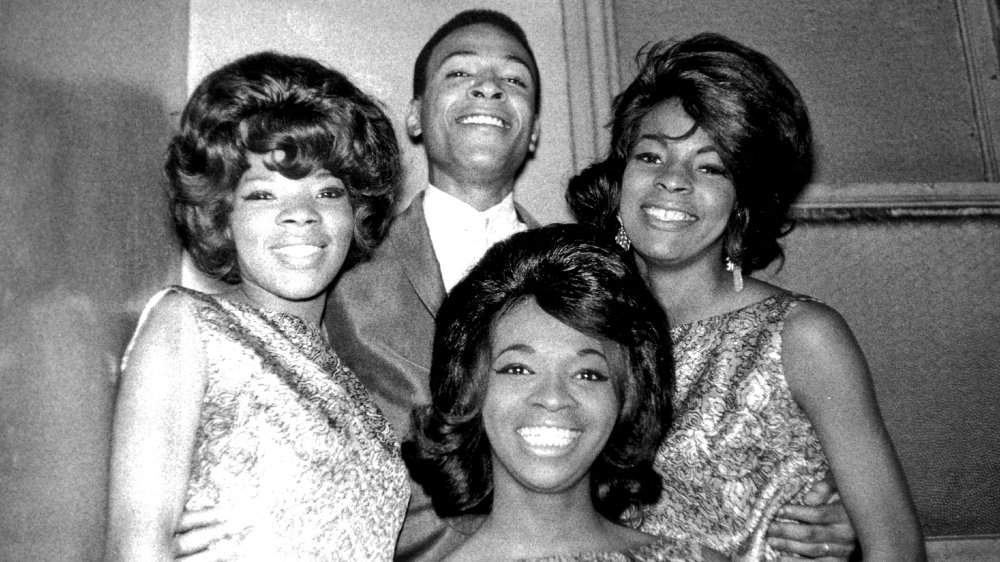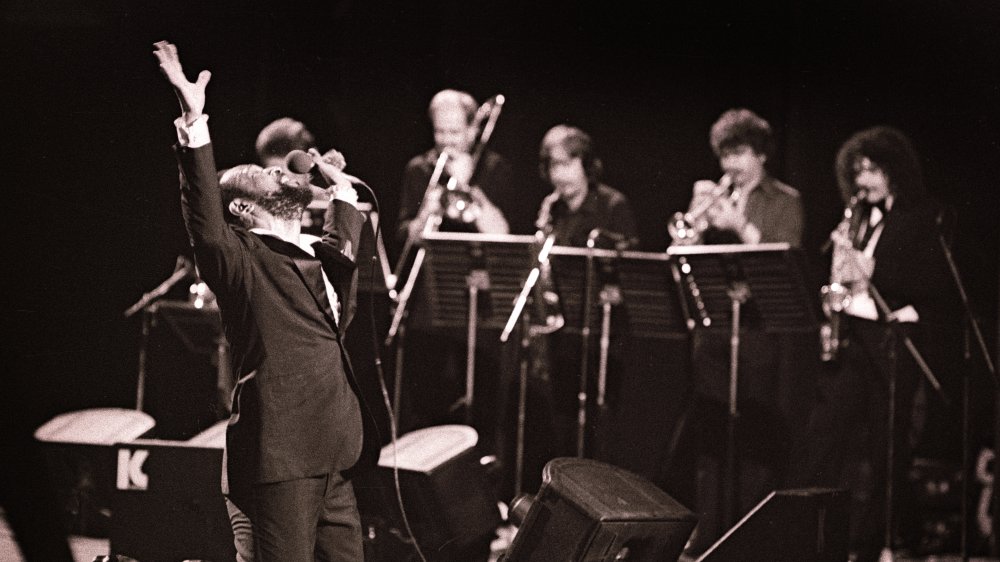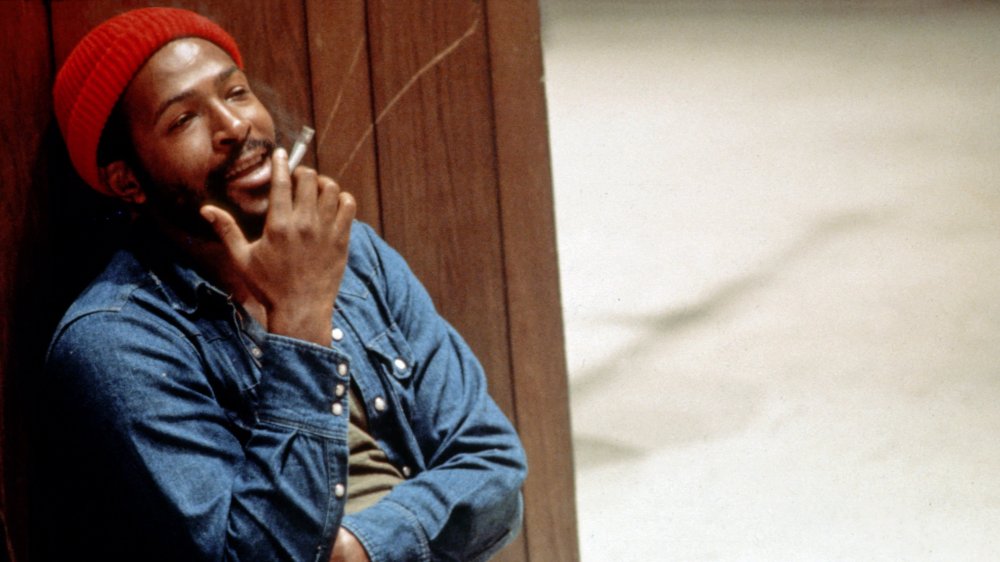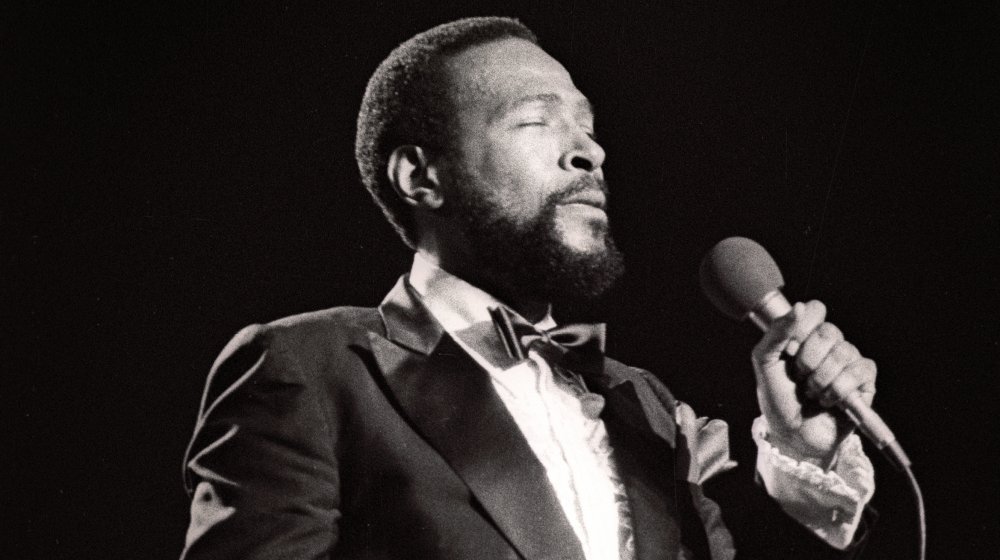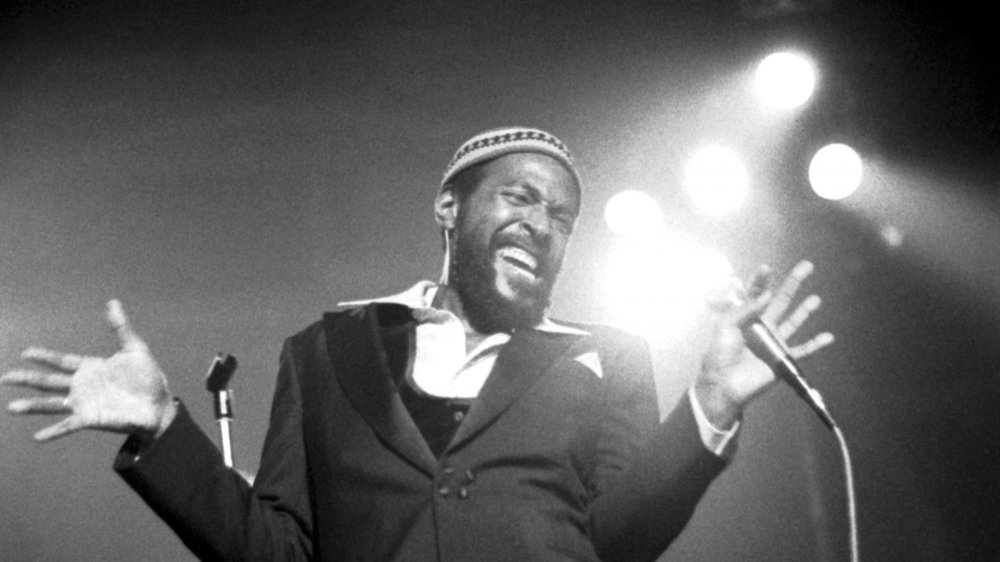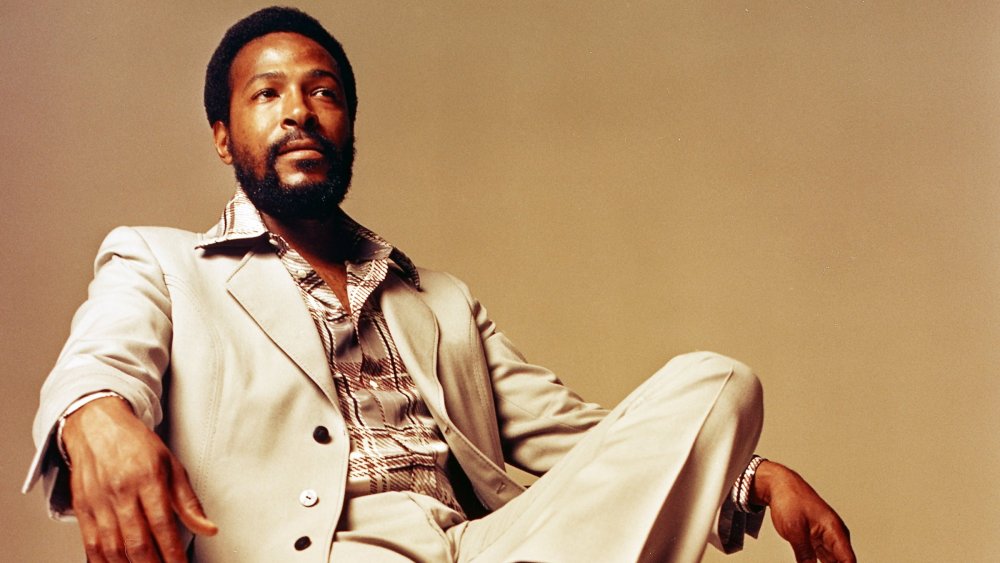What The Last 12 Months Of Marvin Gaye's Life Were Like
We may receive a commission on purchases made from links.
On April 1, 1984, Marvin Gaye died at the hands of his father. The preceding year had been one of dramatic contrast. Despite awards and accolades, the last year of Marvin Gaye's life was an extreme roller coaster. Gaye first rose to prominence with his 1962 hit "Stubborn Kind of Fellow." He swiftly became a Motown staple — not bad for someone who started out as just a drummer. By 1973, he was recording his incredible, three-octave range with the likes of Diana Ross, and he soon began producing his own records, even playing all the instruments himself. Everyone knew that Marvin Gaye was a force to be reckoned with, but it wasn't until his later years that he would start to gain critical acclaim.
By 1984, Gaye had already released 17 studio albums. A frequent flyer on Ebony and Rolling Stone, he was even the source of a few scandals — the most prominent of which involved fleeing to Europe to avoid taxes and alimony.
But Marvin Gaye's legacy isn't just one of soulful music; it's also one of tragedy and heartbreak. It's the story of a broken man, a sometimes cruel man, who nevertheless gave the world some of its most beautiful music, in a time of unparalleled innovation. The last 12 months of Marvin Gaye's life were tumultuous and dark. Here's his story.
Marvin Gaye's slow rise to fame
In February 1983, Gaye's two-decade career was at its peak. Gaye had just won two Grammy Awards for Sexual Healing, Midnight Love was rising into the Top 10, and Gaye had his eighth #1 album on the Top Black Albums chart (now known as R&B/HipHop). After a tumultuous period — and a messy divorce — he was poised for a historic comeback.
Before 1971, Gaye had been releasing almost an album a year for over a decade — but they barely touched the charts. Everyone knew who Marvin Gaye was, and everyone listened to his music. But he wasn't yet being taken seriously.
What's Going On made it to #6 in the United States, and was followed by three massive hits: Trouble Man, Let's Get It On, and I Want You. Still, his next two albums struggled to break into the top 30s, and it appeared as though he might be sliding into obscurity once again. So, when Midnight Love came out, it seemed to usher in an entirely new stage of his career. As noted in Esquire, by 1983 people were finally starting to recognize Gaye as a musical genius, giving him the recognition that he had long deserved.
Marvin Gaye's final performances, from Soul Train to the NBA
The year before his death, Marvin Gaye seemed unstoppable. On February 13, 1983, Gaye sang The Star-Spangled Banner at the NBA All-Star Game. According to TIME Magazine, the NBA called it a "seminal moment in sports history." This performance would later be used for a 2008 Nike commercial — and when VH1 launched on January 1, 1985, the performance was the first video they aired.
A few months later, Gaye performed on Soul Train for the last time. And on May 16, 1983, Marvin Gaye's performance on "Motown 25: Yesterday, Today, and Forever" proved to be as spellbinding as ever — though Gaye was noticeably haggard. These would be his final TV appearances.
Fans of Marvin Gaye can take some solace — Gaye was achieving his career goals. He was now two years out from a brutal divorce, and it appeared as though the worst was over. But behind the scenes, Gaye was struggling. Gaye was far from a perfect man; sex-obsessed and drug-addicted, with a series of broken relationships, Gaye had been struggling with his mental health for some time.
What's going on? Marvin Gaye's paranoia grows
What do you wear to promote your next tour? If you're Marvin Gaye, it's a bulletproof vest, according to Ebony. By early 1983, Gaye had started to spiral into paranoia. He hired bodyguards with loaded guns, took to wearing bulletproof vests, and sent his father the very same gun that would eventually be used to kill him. His father accepted it reluctantly; he had never owned a gun before.
Gaye's ex-wife, Janis Hunter, would later remark in her book After the Dance that Gaye experienced both stage fright and crippling self-doubt. According to the Washington Post, his younger sister, Zeola Gaye, said that he was paranoid and believed that someone was trying to kill him — in truth, it seems as though the only person trying to kill Gaye was himself.
Per Ebony, Marvin Gaye had received several death threats — but this wasn't unusual for a star of his stature. Still, he took them seriously. He told people that he was being stalked. He even called a press conference and told the press that he had hired a lawyer to look into the fact that he had recently been poisoned. In the last months of his life, Marvin Gaye would instruct limo drivers to drive in circles to throw off an unseen pursuer. He would avoid stepping out of elevators on specific floors. He became terrified to go anywhere but his hotel.
Eventually, he would have nowhere to go but home.
Gaye struggled with drugs and depression
A childhood filled with abuse and mistrust was likely part of Marvin Gaye's paranoia. But the other component was, well, an absolutely ridiculous amount of drugs.
As reported by the New York Times, Marvin Gaye was not a stranger to drug use. He started using cocaine in the early 1960s, during his first few studio albums. He became dependent on it through the '70s, also flirting with PCP. Per Ebony, he spent his time between reading scripture and doing cocaine — an unlikely combination for self-soothing.
Perhaps if it was only drug addiction, he could have survived. But in addition to addiction, Gaye had personal demons to fight. By 1983, he had attempted to commit suicide twice, once by ingesting an ounce of cocaine in an hour.
If you or anyone you know is having suicidal thoughts, please call the National Suicide Prevention Lifeline at 1-800-273-TALK (8255).
Marvin Gaye unraveled during his Sexual Healing Tour
In 1983, Marvin Gaye remarked that a tour would likely kill him — but finances, notably his taxes, eventually backed him into a corner. In April 1983, he started the Sexual Healing Tour in San Diego. It would go on until August 14. Creative and controversial as ever, he debuted a military-style outfit, red with gold buttons — now in the Motown Museum. But while the tour itself seemed to be going well, he was falling apart both mentally and physically.
Gaye's paranoia had taken the stage with him during the Sexual Healing Tour. According to The Independent, he'd hired bodyguards — and he had his sister bring water to him while on stage, to avoid poisoning. He was depressed, scared, and exhausted throughout the tour. He was continually convinced that the next town he was going to would be his last. As the tour continued, his health faltered. In Florida, he was hospitalized for exhaustion.
Marvin Gaye's prediction was coming through: The tour was killing him. Unpredictable and paranoid, he returned to his family home.
Marvin Gaye's childhood was a series of brutal whippings
After his tour, Marvin Gaye moved back in with his parents: Marvin Gay Sr. and Alberta Gay (Marvin Gaye had added the "e"). The reunion was tumultuous at best. Gaye's childhood has been described as "a series of brutal whippings," under a strictly religious, Pentecostal household. In Divided Soul: The Life of Marvin Gaye, Gaye described this as "like living with a king, a very peculiar, changeable, cruel and all-powerful king."
Later, in My Brother Marvin, Zeola Gaye would illuminate more about their troubled household. Mr. Gay was an alcoholic and a closeted cross-dresser. He would be kind when he wasn't drinking, and sour when not. Yet even she would go on to defend him: "My father was not a monster."
In his family's home, Gaye continued to do drugs. His mother would recount, tearfully, that each time was "the last time." People continued to bring him drugs in his family home, and he spent his time staring, obsessively, at a gun — which he would eventually throw through his bedroom window, without opening the glass.
The loves and children of Marvin Gaye
During the last year of his life, according to Jet, Gaye's current girlfriend Deborah Derrick reported that she was carrying Marvin's unborn child (she later miscarried). At the time, Derrick remarked that the family tension within the Gay household was simply too much for her. Derrick moved out to her own apartment rather than suffer through it, and urged Gaye to come with her to Europe.
Deborah Derrick certainly wasn't the only woman in Gaye's life during the months before his death. Based on family accounts, women were coming in and out of the Gay house constantly — and frequently suffering from abuse under his volatile temper. But this wasn't just the drugs. Gaye's relationships with women had been rocky in the best of times.
At the time of his death, Marvin Gaye had three children: Nona Gaye, Frankie Gaye, and Marvin Gaye III. Marvin Gaye III had been adopted by Marvin and his first wife, Anna Gordy. His mother was Denise Gordy, Anna's niece, just 15 years old when she became pregnant by Marvin. Nona and Frankie's mother was Janis Hunter, Marvin's second wife — whom he met when she was 17.
A predilection for younger women wasn't exactly unheard of for the musicians of the time — it was the age of Lori Mattix and other star-struck groupies. But it certainly didn't add stability to the Prince of Motown's lifestyle.
Marvin Gaye's final Grammy nomination
In early 1984, Marvin Gaye was nominated for his last Grammy in the Best Male R&B Vocal Performance category for Midnight Love. He wouldn't be nominated again until after his death.
During this time, critical magazines such as Rolling Stone were just starting to awaken to the idea that Gaye might be there to stay. Midnight Love had been well-received, and Gaye appeared to be securing his place in history — even after all the drug abuse and tax evasion. Still, very few knew about the increased paranoia he was experiencing behind the scenes.
In hindsight, of course, Gaye is a monumental figure. At the time, though, he was competing against some of the most memorable musicians of all time. I Heard It Through the Grapevine (previously titled In the Groove), now known as his breakthrough album, only hit #63 on the US Charts — despite the single reaching #1.
It was a competitive year for groundbreaking music — 1968 saw the release of The White Album, Electric Ladyland, Beggars Banquet, and Magical Mystery Tour.
Marvin Gaye's last suicide attempt
Just before his tragic death, Marvin Gaye made one last attempt on his own life. Four days before he was shot and killed, he attempted to jump out of a sports car going 60 MPH. He walked away with just bruising.
According to Essence, he had attempted this multiple times. In 1969, Gaye had thought to shoot himself but was stopped by Motown's Berry Gordy. In 1979, Gaye had ingested an ounce of cocaine, believing it to be more pleasant than a gun. These repeated attempts lent credence to the idea that he was a man struggling to survive.
At this stage of his decline, Gaye was only leaving his house when high. At least once, he was found stumbling on freeway overpasses and brought home. His psychological battle with his father continued, but for the most part, Marvin Gaye remained within his room.
If you or anyone you know is having suicidal thoughts, please call the National Suicide Prevention Lifeline at 1-800-273-TALK (8255).
The shooting of Marvin Gaye: April 1, 1984
"It wasn't simply that my father beat me, though that was bad enough. By the time I was twelve, there wasn't an inch on my body that hadn't been bruised and beaten by him," Marvin Gaye once said, according to Divided Soul: The Life of Marvin Gaye.
It all began with a letter, according to Ebony.
On April 1, 1984, Mr. Gay was angrily storming through the house looking for an insurance letter. He shouted at Mrs. Gay, but she was busy tending to Gaye. Marvin's sister would later note that Gaye was in a state of (perhaps perpetual) undress, likely to unnerve his father even more. Still unable to find the letter, Mr. Gay started to scold Mrs. Gay — and Gaye went to her defense. Eventually, the fight led to Gaye striking his father.
A scuffle ensued, after which Gaye's father came back and shot him twice in the chest — with the pistol that Gaye himself had sent him some months earlier. Later, Gaye's father would say that he thought the pistol was full of BBs. According to Frankie Gaye, his brother, as Marvin lay dying, he said that he had his father shoot him because he couldn't do it himself. Marvin Gaye would be declared dead at 1:01 PM, just one day shy of his 45th birthday.
Marvin Gaye's family reacts
"Marvin knew if he ever touched Father, my father would kill him," Zeola Gaye would later say, per the Washington Post, "It was a mercy killing. Father took Marvin out of his misery."
Many close to Marvin Gaye believed that he committed suicide via his father. According to the Independent, a recorded conversation revealed his security officer warned Gaye that if he kept provoking his father, "he's told you what he'll do."
Perhaps so. But what is it called when someone takes a person out of the misery that they themselves inflicted? What do we make of a world in which a man is shot twice in the chest by his own father, and everyone declares it suicide?
Marvin Gaye's father, in his incredible power and cruelty, was regarded by the Gay family as nothing less than a force of nature. Marvin's mother, sisters, and even family friends later painted the tragic incident as an intentional provocation by Marvin Gaye.
If you or anyone you know is having suicidal thoughts, please call the National Suicide Prevention Lifeline at 1-800-273-TALK (8255).
The legacy of Marvin Gaye
Marvin Gaye would be inducted into the Rock and Roll Hall of Fame in 1987 and earned the Grammy Lifetime Achievement Award in 1996 — despite a life cut short. In his honor, the Marvin P. Gaye Jr. Memorial Foundation was established, and April 2nd, 1985 was declared to be the Marvin Gaye Junior Scholarship Fund Day. Four albums have been posthumously released, as recently as 2019, according to The Undefeated. His estate was even mired in some legal battles in 2018 when Robin Thicke's "Blurred Lines" was found to be notably similar to one of his tracks.
In the last months of Marvin Gaye's life, he was, by many accounts, abusive, paranoid, and destructive. He found solace in cocaine and pornography and terrorized members of his family. But the last months of Gaye's life don't tell the entire story; the story of a child dominated by a father who would eventually go on to kill him.
Though Marvin Gaye may have been at the height of his career in 1984, it didn't erase the harm and tragedy that he had lived through. His suicidal inclinations, drug abuse, and the string of younger partners were all the habits of a man desperately trying to hide — from himself, from the world, and from the man who had brought him into it.
